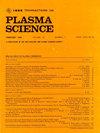Bacterial Aerosol Inactivation by DBD Plasma: Mechanisms, Kinetic Model, and Disinfection Dose
IF 1.5
4区 物理与天体物理
Q3 PHYSICS, FLUIDS & PLASMAS
引用次数: 0
Abstract
Atmospheric pressure dielectric barrier discharge (DBD) plasma has emerged as a promising method for efficient air disinfection in building environments. However, the mechanisms, kinetics, and disinfection doses required for bioaerosol inactivation by plasmas remain inadequately understood. In this study, we first applied optical photothermal infrared (O-PTIR) spectroscopy to examine the biological responses of bacterial aerosols to plasmas at the single-cell level. Significant carbonylation was observed in plasma-treated cells, indicating that oxidation is a crucial mechanism in bacterial aerosol inactivation. A preliminary multispecies kinetic model was proposed for bioaerosol disinfection by plasmas. By differentiating the roles of charged particles and neutral chemical species, the equivalent total chemical dose (ETCD) and equivalent total ionic dose (ETID) were introduced. ETCD primarily considers the oxidation potential of the reactive species in the plasma. The proposed model was applied to a DBD plasma-based air disinfection system and preliminarily validated. The relationship between the macroscopic dose (specific energy density, SED) and microscopic dose (ETCD) was uncovered. This study provides valuable insights into the modeling of plasma-bioaerosol interactions and the underlying mechanisms, offering a theoretical foundation for practical applications.DBD等离子体对细菌气溶胶灭活:机理、动力学模型和消毒剂量
大气压介质阻挡放电(DBD)等离子体已成为一种很有前途的高效建筑环境空气消毒方法。然而,等离子体灭活生物气溶胶的机制、动力学和消毒剂量仍未得到充分的了解。在这项研究中,我们首次应用光学光热红外(O-PTIR)光谱在单细胞水平上研究了细菌气溶胶对等离子体的生物学反应。在等离子体处理的细胞中观察到显著的羰基化,表明氧化是细菌气溶胶失活的关键机制。初步建立了等离子体生物气溶胶消毒的多物种动力学模型。在区分带电粒子和中性化学物质作用的基础上,引入了等效总化学剂量(ETCD)和等效总离子剂量(ETID)。ETCD主要考虑等离子体中活性物质的氧化电位。将该模型应用于基于DBD等离子体的空气消毒系统,并进行了初步验证。揭示了宏观剂量(比能密度,SED)与微观剂量(ETCD)之间的关系。本研究为等离子体-生物气溶胶相互作用的建模及其潜在机制提供了有价值的见解,为实际应用提供了理论基础。
本文章由计算机程序翻译,如有差异,请以英文原文为准。
求助全文
约1分钟内获得全文
求助全文
来源期刊

IEEE Transactions on Plasma Science
物理-物理:流体与等离子体
CiteScore
3.00
自引率
20.00%
发文量
538
审稿时长
3.8 months
期刊介绍:
The scope covers all aspects of the theory and application of plasma science. It includes the following areas: magnetohydrodynamics; thermionics and plasma diodes; basic plasma phenomena; gaseous electronics; microwave/plasma interaction; electron, ion, and plasma sources; space plasmas; intense electron and ion beams; laser-plasma interactions; plasma diagnostics; plasma chemistry and processing; solid-state plasmas; plasma heating; plasma for controlled fusion research; high energy density plasmas; industrial/commercial applications of plasma physics; plasma waves and instabilities; and high power microwave and submillimeter wave generation.
 求助内容:
求助内容: 应助结果提醒方式:
应助结果提醒方式:


